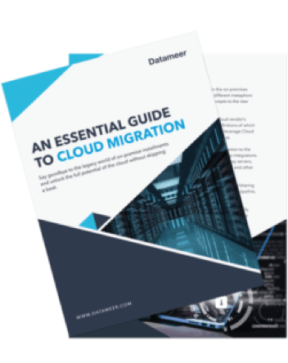
An Essential Guide to Cloud Migration
As if managing data of increasing size weren’t hard enough, organizations are now challenged to monitor business processes, assemble complete views of customers, and weave a cohesive analysis of corporate performance based on hybrid data that are strewn across the traditional enterprise and multiple clouds.

About the Cloud Migration Ebook
Cloud migration is the process of moving data, applications, and IT activities to the public cloud. In most cases, the source is on-premises data centers, often legacy infrastructure. But in other cases, cloud migration also describes moving from one cloud to another (e.g., from Azure to AWS).
The public cloud offers obvious benefits. First of all, there is scalability and performance. Public cloud providers offer unlimited scale for data storage and processing compute. Instead of designing one’s own infrastructure to handle today’s and tomorrow’s workloads, cloud vendors provide elastic scaling on-demand and in minutes.
Secondly, the cloud delivers cost savings. Cloud pricing models mostly charge for only what has been used. In many cases, this is true for infrastructure and native cloud services and third-party SaaS applications. In addition, a reduced need for IT expertise can be a huge cost saver as well.
Cloud Migration Benefits
Scalability and performance. Cost savings. Agility and flexibility.
Cloud Migration Challenges
Data gravity. Migrating Applications. Continuing Operations during migration. Testing.
Datameer Spectrum
An agile data fabric enables you to build scalable, secure data pipelines to migrate analytics workloads to the cloud.
Datameer Spectrum for Cloud Migration
Connectivity. ETL vs. ELT. Data Curation and Transformation. Governance, metadata, lineage. Security. Migrating Applications.
GUIDE TO CLOUD MIGRATION: CHALLENGES
The benefits of public clouds are broadly well understood, and the trend of cloud migration is visible and has accelerated for quite a few years now. However, although SMBs and cloud-native companies adopted the cloud very early on, large enterprises and highly regulated industries hesitated. Cloud migration, after all, is not as easy as pressing a button. It requires a well-thought-through strategy-especially if established processes are very complex.
Data Gravity – Datasets grow bigger and bigger, they become harder and harder to move.
Applications – Migration is not only about data. It’s also about the applications that serve business needs.
Continued Operations – Companies need to ensure business-critical operations remain in place until switching over. This may even require data and applications to be available in two places for a period of time.
Testing – Switching to an entirely new environment requires intensive testing. For example, you may need to test data integrity, performance, and security.
DATAMEER SPECTRUM FOR CLOUD MIGRATION
Connectivity – Spectrum ships with over 80 connectors that provide access to all common data sources and types. This includes traditional data warehouses, cloud and on-prem data lakes, and all cloud object stores. Whether it’s structured or unstructured, small or huge volumes, a point-and-click wizard connects to all of it in minutes.
ETL Vs ELT – In some cases, you will feed the target system with curated and consumable data. In others, transformations might be delegated to the destination. When it comes to data management and resource utilization, data copies can be painful. But sometimes, they are part of a strategy to stage and reflect various transformation snapshots.
Data Curation and Transformation – Data often has to be transformed during migration. You might want to parse, cleanse, or model it for downstream usage, or you may apply a schema if the destination is a data warehouse. Spectrum offers over 300 Excel-like functions for easy transformation and curation to satisfy data engineering, data science, and self-service analyst needs.
Governance, Metadata, Lineage – It’s important to understand and document which data goes where and how it gets transformed over various steps in the process. Spectrum tracks all this automatically with full lineage support. Column metrics and profiles help validate data integrity, ensuring that the data quality is not adversely affected during the transfer process.